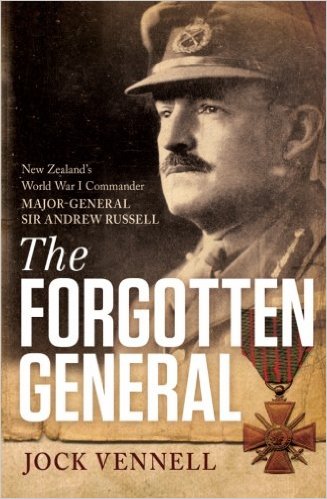Major-General Sir Andrew Russell, GOC the NZ Division in France. This driven perfectionist succeeded in forging his division into an elite fighting force; but although he was superior to Gen Godley as a fighting commander, he was little warmer as a personality – he was very sparing with praise, and refused to recommend any deserving officer for a Victoria Cross. After an excellent performance in the planning and execution of the Messines Ridge attack in June 1917, he was judged to have let his men down at Passchendaele that October. Aware that his troops were exhausted, and would have insufficient artillery support, he failed to advise his superiors or to seek a postponement of the attack. The losses suffered threatened to break the morale of the `Silent Division’, but after being rebuilt it performed excellently in 1918.
Andrew Russell (1868-1960) was the first New Zealand-born commander of the NZ Division, and proved to be its most effective. He had been born into a military family, and after education in England at Harrow and Sandhurst he was commissioned into a British regular battalion, serving in India and Burma. He later resigned from the regular army to take up sheep farming on the family estate in New Zealand. He became active in the Volunteer and Territorial forces, eventually being selected by Godley to command the 2nd (Wellington) Mounted Rifle Bde in 1911. He declined a regular commission in the NZ Staff Corps prior to the war, but sailed with the Main Body of the NZEF in October 1914 as the highest-ranking Territorial officer, as the brigadier commanding the NZ Mounted Rifle Brigade.
At Gallipoli, Russell earned a reputation as a professional and competent commander. His brigade disembarked on 13 May 1915 at Anzac Cove, where it was employed as infantry in the northern section of the beachhead. Russell established his HQ only 25 yards from the support trenches, on a plateau that became known as Russell’s Top; it was here that his men repelled a large Turkish attack on 19 May, securing the area for future operations. In the August offensive Russell’s brigade seized the formidable foothills of Chunuk Bair, allowing the infantry to assault the strategic summit. Australian war correspondent C. E. W. Bean proclaimed this action to be a `magnificent feat of arms, the brilliance of which was never surpassed, if indeed equalled, during the campaign.’ For such feats Russell was knighted, and he assumed command of the ANZAC division in November 1915. His performance as one of the few commanders to establish a favourable reputation on the peninsula made him the obvious choice to command the New Zealand Division when it was later formed in Egypt.
Leading the NZ Division on the Western Front, Russell was determined to produce the best fighting division in France, and developed his command from a raw and inexperienced formation into an elite veteran force. He was ruthlessly efficient in ensuring that the troops were led by competent officers, and that the men received the appropriate training before any offensive. This was especially true after the division suffered heavy casualties when thrust ill-prepared into the Somme fighting in September 1916. Russell was a hard task-master; he sent back to New Zealand officers who had not performed to the required level, and he regularly made unheralded inspections of front-line units to promote discipline and efficiency.
Russell showed high moral courage in rejecting Field Marshal Haig’s plan for the capture of Messines Ridge, formulating his own, which involved weeks of preparation and full-scale rehearsal over similar ground. This resulted in the rapid capture of Messines village and the ridge with minimal losses. However, Russell was not at his best at Passchendaele, which proved to be New Zealand’s worst military disaster. With only a few days available to prepare for the offensive, Russell failed to apply his usual attention to detail, and on 12 October 1917 the NZ Division suffered over 3,000 casualties. As a perfectionist, Russell drove himself to the point that he was continually ill throughout 1918. However, his relentless drive ensured that the New Zealanders were a key formation in the defeat of the German offensive of March 1918, and in the triumphant counteroffensive later that year that led to the Armistice.
The Forgotten General – New Zealand’s World War I Commander Major-General Sir Andrew Russell
